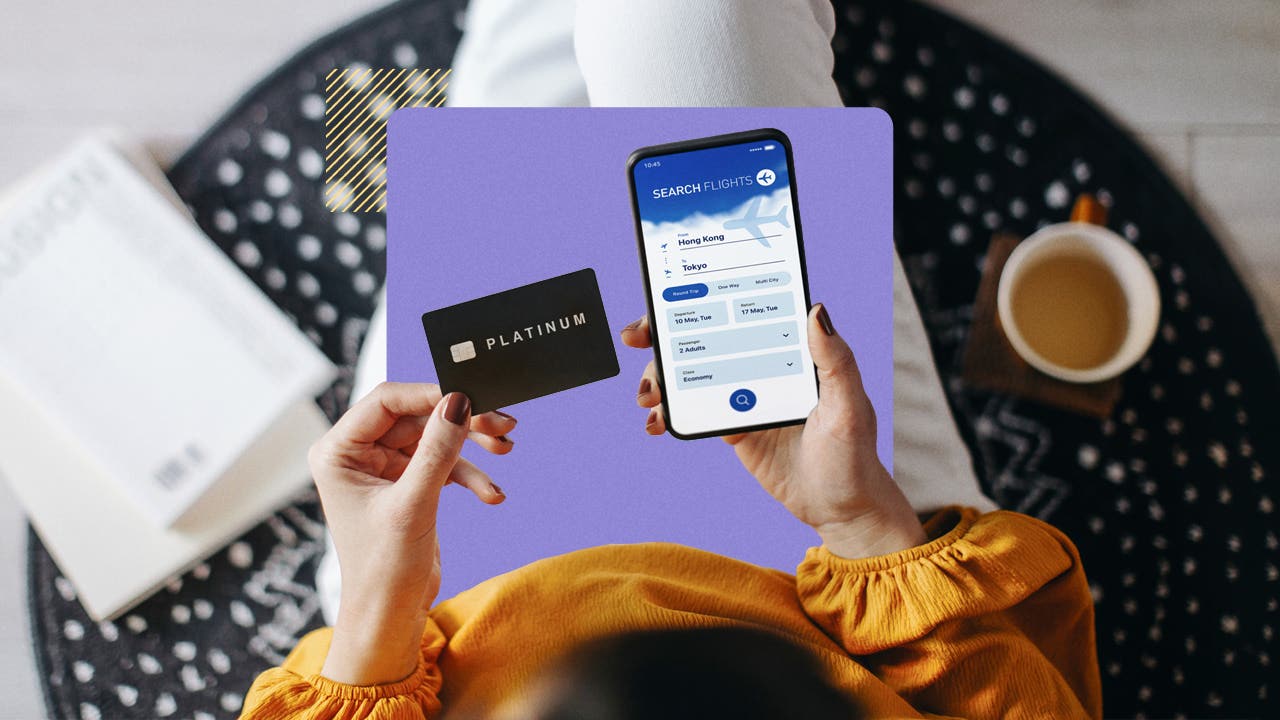From scroll to shop: How to wisely navigate impulse buying, especially on credit cards

The Bankrate promise
At Bankrate we strive to help you make smarter financial decisions. While we adhere to strict , this post may contain references to products from our partners. Here's an explanation for . The content on this page is accurate as of the posting date; however, some of the offers mentioned may have expired. Terms apply to the offers listed on this page. Any opinions, analyses, reviews or recommendations expressed in this article are those of the author’s alone, and have not been reviewed, approved or otherwise endorsed by any card issuer.
Key takeaways
- Impulse buying has a negative impact on your overall financial health, as it can cause you to overspend beyond what you can afford.
- All generations and age groups are susceptible to impulse buying (and carrying multiple credit cards to support the habit).
- Social media is a common trigger for impulse buying, as videos or posts promoting products or services can be especially tempting.
- You can avoid impulse purchasing by setting a budget, tracking spending, avoiding tempting stores and using cash instead of credit cards.
Plastic in your pocket can easily lead to temptation. When you consider how convenient and common it is for consumers to charge purchases to their credit cards, it’s no wonder that card balances nationwide now total over $1 trillion.
Social media has contributed to this overspending problem, including influencers whose content persuades Americans to emulate expensive lifestyles and want things others have. But regardless of the source, the truth is that purchasing on impulse and buying on credit things you cannot afford can result in buyer’s remorse and serious credit card debt.
To protect your finances, take the time to learn more about the causes and dangers of impulse buying, social media’s influence on impulse purchasing, credit card spending patterns, why impulse buying on a credit card is a bad idea, how to be smart when shopping with a credit card and our recommendations for curbing impulse charging.
Understanding impulse buying
Generally speaking, impulse purchasing refers to unplanned purchases — spur-of-the-moment decisions to buy something.
“It occurs when you purchase an item on a credit card at a whim, without planning or budgeting beforehand properly. Many impulse buyers either don’t consider the future impact of these purchases or assume they will figure it out later, getting caught up in the moment of the purchase,” explains Grant Gallagher, head of Financial Wellbeing and Brand Communications at Affinity Federal Credit Union.
Ted Rossman, senior industry analyst for Bankrate, notes that credit cards can facilitate impulse purchases because they make it so easy to buy things just about any time, anywhere.
“You can just click a few buttons on your computer or phone and the purchase is done,” he says.
Impulse buying can be fueled by a desire for instant gratification: You see something and you immediately want it.
“Purchasing fun or recreational items can trigger the brain’s reward center. The emotional side of your brain can very easily overcome the rational,” Gallagher continues. “Also, going out to stores to ‘just get ideas’ or browse around can often result in unplanned purchases.”
Impulse buying on credit cards insights
- 23 percent of U.S. adults with a social media account have made an impulse purchase in the past year that they regret. (Bankrate)
- Over the past year, 26 percent of adults who have social media and made an impulse purchase spent over $500. (Bankrate)
- 20 percent of all impulse purchases are made with a credit card. (Gitnux)
- Social media accounted for 33 percent of all digital advertising spending in 2022. (Hootsuite)
- 77 percent of impulse purchases are physical goods, with clothing, shoes and accessories being the top categories. (Gitnux)
Social media influence on impulse buying
One major reason why consumers purchase on a whim and overspend on their credit cards is social media.
“Friends, acquaintances and influencers are all looking to put their best foot forward on social media,” Rossman adds. “There can be a ‘keeping up with the Joneses’ element to this. You don’t necessarily know how much someone spent on that supposedly perfect look or vacation or whether or not they took on debt to afford it. Maybe the experience or item wasn’t even all it cracked up to be. Social media can distort perception and reality.”
Consider that many social media influencers are constantly promoting products because doing so earns them revenue. In other words, that video or post you see featuring someone raving about the newest shoes, car, jewelry, makeup, clothing or other item may not be a truthful endorsement of that product — it’s likely that the influencer is incentivized to publicize and say positive things about the merchandise.
Couple the outsized influence these social media players have on consumers with the instant convenience of online shopping — where a transaction can be completed in seconds using your phone or PC — and it’s easy to see how overspending and buyer’s remorse can result.
Credit card spending patterns
Make no mistake: Every generation/age group is susceptible to impulse buying.
First, here’s a look at the average number of cards held by generation:
| Generation | Average number of credit cards |
|---|---|
| Baby Boomers | 3.4 |
| Generation X | 3.3 |
| Millennials | 2.7 |
| Silent Generation | 2.7 |
| Generation Z | 1.7 |
Now, take a look at the dollars spent by social media users who have made an impulse buy inspired by social media over the past year:
| Amount spent on impulse purchases inspired by social media | Gen Z (ages 18-26) | Millennials (ages 27-42) | Gen X (ages 43-58) | Boomers (ages 59-77) |
|---|---|---|---|---|
| Source: Bankrate/YouGov | ||||
| $1-$49 | 16% | 13% | 18% | 21% |
| $50-$99 | 13% | 11% | 13% | 17% |
| $100-$199 | 18% | 19% | 21% | 28% |
| $200-$499 | 22% | 24% | 25% | 22% |
| $500+ | 30% | 33% | 22% | 13% |
Of those who made an impulse purchase inspired by social media in the past year, Gen Z and Millennial consumers disproportionately outspent Gen X and Boomer survey respondents.
- Gen Z: $844 ($200 median)
- Millennials: $1,016 ($200 median)
- Gen X: $522 ($150 median)
- Boomers: $418 ($100 median)
A similar trend can be seen when looking at the percentage of social media users, by demographic, who made an impulse purchase inspired by social media in the past year that totaled at least $500.
- Gen Z: 30 percent
- Millennials: 33 percent
- Gen X: 22 percent
- Boomers: 13 percent
For further consideration, male social media users spent $999 on average ($200 median) on social media driven impulse purchases, versus $518 (median $150) for women. Thirty-one percent of men surveyed spent at least $500 on these purchases, compared to 21 percent of women.
Why is impulse buying on a credit card a bad idea?
Credit cards can come in handy, especially when you don’t want to carry cash or want to complete a transaction quickly on your phone or other device.
“But using a credit card for an impulse buy could encourage overspending,” cautions Rossman. “The average credit card interest rate is a record high 20.68 percent. That overspending is particularly costly if you are financing it over time at an interest rate north of 20 percent.” cautions Rossman.
When impulse buying becomes a chronic behavior, credit card debt can result.
According to Gallagher, “As impulse buying becomes a trend in your everyday life, the debt further accumulates, leaving you with high credit card bills, forcing you to try opening new credit cards or extending your credit limit to purchase even more.”
That can lead to a vicious cycle of snowballing debt that can ruin your credit if you’re not careful. Plus, when you overspend and over-rely on credit cards, “money is being pulled away from your monthly budget that could go to more important expenses or purchases and directed toward various financial goals like retirement savings,” Andrea Woroch, a personal finance expert, notes.
Impulse spending can even be bad for your mental health. Consider that 52 percent of U.S. adults surveyed said that money has a negative impact on their mental health, at least occasionally.
Money tip: Avoid credit card debt by setting and sticking to a budget and making your payments on time and in full (if possible) every month.
Being smart while shopping with a credit card
It’s always best to practice caution with credit cards and to choose the right cards for your needs. In particular, try to apply for and use cards that don’t charge exorbitantly high interest rates or an annual fee.
Also, “don’t spend more than you can afford. Make sure to pay your balance in full every month to avoid interest charges,” suggests Rossman. “And consider paying your credit card bills more than once a month to stay on top of your spending and boost your credit score.”
For individuals who carry credit card debt that could be caused by impulse purchases, a balance transfer credit card can help you pay off your debt by transferring existing card balances to a new credit card with a 0 percent intro APR period. Doing so can help you to pay off debt by freeing up money that would have otherwise been spent on interest alone.
You can also use credit cards that offer rewards to help save money or earn points toward freebies you would otherwise spend cash on, such as airline miles, hotel stays or gift cards.
Tips on how to stop impulse buying
Determined to avoid impulse buying? Follow these best practices:
- Set a budget and stick to it. “Setting a budget and tracking your expenses ensures you know what you can afford to spend each month,” says Woroch.
- Bypass tempting stores and shops. “You probably know which stores you are vulnerable to when it comes to impulse purchases, so either avoid those retailers or always shop with a list and try to stick to it,” Gallagher advises. Woroch also recommends deleting shopping apps on your phone, turning off push notifications and unsubscribing from store newsletters to further reduce spending temptations.
- Institute a waiting period. “A 24-hour cooling-off period would work well,” says Rossman. “For larger amounts, you might even want to hold off for a week or more.”
- Don’t save your credit card information online. “Having to find a card and type in the number might be enough of a deterrent to buying something you don’t really need,” Rossman adds.
- Stick with cash when running to the store. “Using cash can quickly curb unnecessary spending, as studies show you are less likely to part with your dollars on things you really don’t need when paying with actual dollars than a card,” Woroch points out.
- Be wary of social media claims and promotions. “Keep in mind that what you see on social media isn’t always realistic. That refers to your friends’ posts and perhaps rings even more true for influencers,” says Rossman. “We are conditioned to want to put our best foot forward, but keeping up with the Joneses can land you in debt. And buying whatever you see in that perfectly posed photo probably doesn’t contain the key to happiness.”
The bottom line
By taking a closer look at your spending and credit card charging habits, determining which stores and sites you are most triggered to purchase at, firming up a budget and spending plan and resisting the urge to buy on a whim after seeing a tempting social media post, you can condition yourself to sidestep bad habits like impulse buying, overspending and overusing credit cards.
Before you head to checkout, Gallagher recommends asking yourself: “Why do I want this? How many times will I use this product or service? Can I pay this off on my credit card bill at the end of the month? And will I regret buying this?”
Related Articles



